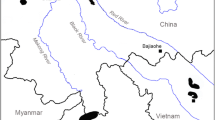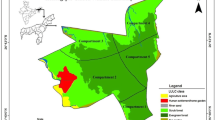Abstract
Most gibbons dwell in the tropical forests of Southeastern Asia, but eastern hoolock gibbons (Hoolock leuconedys) survive in high montane forest ranging from 1,600 to 2,700 m a.s.l. in Gaoligongshan (>24°30′N), Yunnan, China. To assess the behavioral adaptations of hoolock gibbons to the montane forest, we related temperature and food availability within the habitat to the seasonal behavioral patterns of a family group and a solitary female between August 2010 and September 2011 in Nankang, Gaoligongshan National Nature Reserve. The maximum temperature was 29.2 °C and the minimum temperature was −0.3 °C during the period. The monthly mean temperature was <10 °C between December and February, making Nankang the coldest gibbon habitat reported so far. Nonfig fruit and fig availability declined to nearly zero in cold months. The family group increased resting and decreased travel and social behaviors when the monthly mean temperature was low. Compared with other gibbon populations, the hoolock gibbons spent proportionally less time feeding on figs and other fruit than other gibbon populations except Nomascus concolor and Symphalangus syndactylus. Only 36 species of plants provided nonfig fruit or figs, which is less than the number of fruit species consumed by any other gibbon population observed during a similar period of time (about 1 year). Hoolock gibbons shifted their diet to leaves and increased feeding time when fruit was not available. We conclude that diet flexibility and an energy-conserving strategy during the cold season when fruit is scarce have enabled the hoolock gibbons to survive in a northern montane forest.




Similar content being viewed by others
References
Ahsan MF (2001) Socio-ecology of the hoolock gibbon (Hylobates hoolock) in two forests of Bangladesh. In: The apes: challenges for 21st century. Conference proceedings. Brookfield Zoo, Brookfield, pp 286–299
Altmann J (1974) Observational study of behaviour: sampling methods. Behaviour 49:227–267
Altmann SA (1998) Foraging for survival. Chicago University Press, Chicago
Bartlett T (2007) The hylobatidae, small apes of Asia. In: Campbell CJ, Fuentes A, MacKinnon KC, Panger M, Bearder SK (eds) Primates in perspective. Oxford University Press, New York, pp 274–289
Bartlett T (2009) The gibbons of Khao Yai: seasonal variation in behaviour and ecology. Allyn & Bacon, Boston, p 170
Brockelman WY, Naing H, Saw C, Moe A, Linn Z, Moe TK, Win Z (2009) Census of eastern hoolock gibbons (Hoolock leuconedys) in Mahamyaing Wildlife Sanctuary, Sagaing Division, Myanmar. In: Lappan S, Whittaker DJ (eds) The gibbons, new perspectives on small ape socioecology and population biology. Springer Science + Business Media, LLC, pp 435–452
Chapman CA, Chapman LJ, Wangham R, Hunt K, Gebo D, Gardner L (1992) Estimators of fruit abundance of tropical trees. Biotropica 24:527–531
Choudhury A (2001) Primates in northeast India: an overview of their distribution and conservation status. In: Gunpta AK (ed) ENVIS bulletin: wildlife and protected areas (non-human primates of India), vol 1, pp 92–101
Das J, Feeroz MM, Islam MA, Biswas J, Bujarborua P, Chetry D, Medhi R, Bose J (2003) Distribution of hoolock gibbon (Bunopithecus hoolock hoolock) in India and Bangladesh. Zoo’s Print J 18:969–976
Das J, Biswas J, Bhattacherjee PC, Mohnot SM (2009) The distribution and abundance of hoolock gibbons in India. In: Lappan S, Whittaker DJ (eds) The gibbons, new perspectives on small ape socioecology and population biology. Springer Science + Business Media, LLC, pp 409–434
Fan PF, Ni QY, Sun GZ, Huang B, Jiang XL (2008) Seasonal variations in the activity budget of Nomascus concolor jingdongensis at Mt. Wuliang, central Yunnan, China: effects of diet and temperature. Int J Primatol 29:1047–1057
Fan PF, Ni QY, Sun GZ, Huang B, Jiang XL (2009) Gibbons under seasonal stress: the diet of the black crested gibbon (Nomascus concolor) on Mt. Wuliang, central Yunnan, China. Primates 50:37–44
Fan PF, Xiao W, Huo S, Ai HS, Wang TC, Lin RT (2011a) Distribution and conservation status of Hoolock leuconedys in China. Oryx 45:129–134
Fan PF, Fei HL, Scott MB, Zhang W, Ma CY (2011b) Habitat and food choice of the critically endangered cao vit gibbon (Nomascus nasutus) in China: implications for conservation. Biol Conserv 144:2247–2254
Fan PF, Fei HL, Ma CY (2012) Behavioral responses of Cao Vit gibbon (Nomascus nasutus) to variations in food abundance and temperature in Bangliang, Jingxi, China. Am J Primatol 74:632–641
Gao YT, Wen HR, He YH (1981) The change of historical distribution of Chinese gibbons (Hylobates). Zool Res 2:1–8
Gittins SP (1982) Feeding and ranging in the agile gibbon. Folia Primatol 38:39–71
Grueter CC, Li DY, Ren BP, Wei FW, Xiang ZF, van Schaik CP (2009) Fallback foods of temperate-living primates: a case study on snub-nosed monkeys. Am J Phys Anthropol 140:700–715
Hanya G (2004a) Diet of a Japanese macaque troop in the coniferous forest of Yakushima. Int J Primatol 25:55–71
Hanya G (2004b) Seasonal variations in the activity budget of Japanese macaques in the coniferous forest of Yakushima: effects of food and temperature. Am J Primatol 63:165–177
Hanya G, Aiba S (2010) Fruit fall in tropical and temperate forests: implications for frugivore diversity. Ecol Res 25:1081–1090
Hill RA, Barrett L, Gaynor D, Weingrill T, Dixon P, Payne H, Henzi SP (2003) Day length, latitude and behavioural (in)flexibility in baboons (Papio cynocephalus ursinus). Behav Ecol Sociobiol 53:278–286
Hu Y, Xu HW, Yang DH (1990) Feeding ecology of the white-cheek gibbon (Hylobates concolor leucogenys). Acta Ecol Sin 10:155–159
Islam MA, Feeroz MM (1992) Ecology of hoolock gibbon of Bangladesh. Primates 33:451–464
Jiang XL, Luo ZH, Zhao SY, Li RZ, Liu CM (2006) Status and distribution pattern of black crested gibbon (Nomascus concolor jingdongensis) in Wuliang Mountains, Yunnan, China: implication for conservation. Primates 47:264–271
King B, Farrow D, Robson C, Buck H, Fisher T (1995) Recent hoolock gibbon, Hylobates hoolock, observations in west Myanmar (Burma). Nat Hist Bull Siam Soc 43:367–368
Lappan S (2009) Flowers are an important food for small apes in Southern Sumatra. Am J Primatol 71:624–635
Li YM (2006) Seasonal variation of diet and food availability in a group of Sichuan snub-nosed monkeys in Shennongjia Nature Reserve, China. Am J Primatol 68:217–233
McConkey KR, Aldy F, Ario A, Chivers DJ (2002) Selection of fruit by gibbons (Hylobates mulleri × agilis) in the rain forest of Central Borneo. Int J Primatol 23:123–145
McConkey KR, Ario A, Aldy F, Chivers DJ (2003) Influence of forest seasonality on gibbon food choice in the rain forests of Barito Ulu, Central Kalimantan. Int J Primatol 24:19–32
Palombit RA (1997) Inter- and intraspecific variation in the diets of sympatric siamang (Hylobates syndactylus) and lar gibbons (Hylobates lar). Folia Primatol 68:321–337
Poulsen JR, Clark CJ, Smith TB (2001) Seasonal variation in the feeding ecology of the grey-cheeked mangabey (Lophocebus albigena) in Cameroon. Am J Primatol 54:91–105
Raemaekers J (1978) Changes through the day in the food choice of wild gibbons. Folia Primatol 30:194–205
Tilson RL (1979) Behaviour of hoolock gibbon (Hylobates hoolock) during different seasons in Assam, India. J Bombay Nat Hist Soc 76:1–16
Ting S, Hartley S, Burns KC (2008) Global patterns in fruiting seasons. Global Ecol Biogeogr 17:648–657
Tsuji Y, Kazahari N, Kitahara M, Takatsuki S (2008) A more detailed seasonal division of the energy balance and the protein balance of Japanese macaques (Macaca fuscata) on Kinkazan Island, northern Japan. Primates 49:157–160
Whitten AJ (1982) Diet and feeding behaviour of Kloss gibbons on Siberut Island, Indonesia. Folia Primatol 37:177–208
Xiang ZF, Huo S, Xiao W (2010) Activity budget of Rhinopithecus bieti at Tibet: effects of day length, temperature and food availability. Curr Zool 56:650–659
Zhang XY, Zhou W, Wu JP, Bai B, Li ZB, Li JH (2008) Food selection of hoolock gibbon (Hoolock hoolock) at Nankang, Mt. Gaoligong in Spring. Zool Res 29:174–180
Acknowledgments
This study was supported by a Rufford Small Grant, National Natural Science Foundation of China (#31160424), Provincial Natural Science Foundation of Yunnan (2009ZC124M), and Fauna and Flora International. P.-F.F is grateful to Dr. Cyril Grueter for his kind invitation to submit this paper to the special issue on “Temperate Primates.” We are grateful to Dr. Goro Hanya, Dr. Cyril Grueter, Dr. Yamato Tsuji, Dr. Warren Brockelman, and Dr. Kim McConkey for their valuable comments and English editing.
Author information
Authors and Affiliations
Corresponding author
About this article
Cite this article
Fan, PF., Ai, HS., Fei, HL. et al. Seasonal variation of diet and time budget of Eastern hoolock gibbons (Hoolock leuconedys) living in a northern montane forest. Primates 54, 137–146 (2013). https://doi.org/10.1007/s10329-012-0336-0
Received:
Accepted:
Published:
Issue Date:
DOI: https://doi.org/10.1007/s10329-012-0336-0




